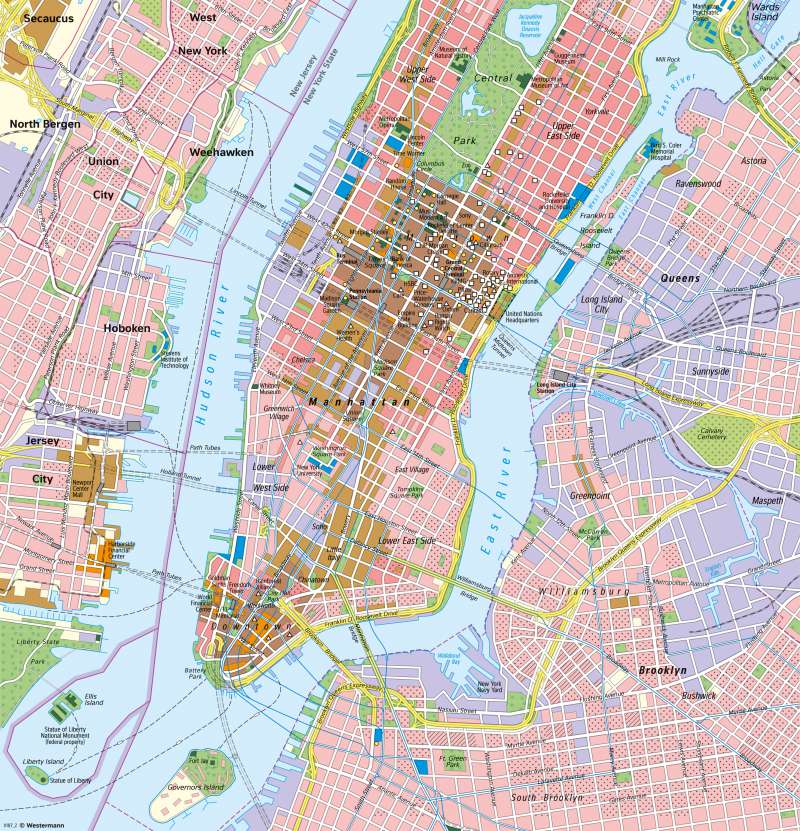Manhattan (New York) - Commercial and business centres
East Coast cities
978-3-14-100890-6 | Page 190 | Ill. 3

Overview
Manhattan is the central district of New York. It is barely three kilometres from the United Nations building on the East River across the island to the banks of the Hudson River and Broadway is approximately 25 kilometres long. There is hardly any other place in the world where so many people live and work in such a confined space. Every day, commuters from suburbs and surrounding districts, the "boroughs", double the number of people in Manhattan, from around 1.6 million to up to 3.9 million. Manhattan's underground network has a length of over 350 kilometres, more than 450 stations and carries 1.7 billion passengers per year.
City layout of Manhattan
A general difference between New York and many major European cities is the chessboard-like layout, which indicates that the city has not grown historically but has been laid out according to plan. This makes orientation in Manhattan easy. The "Streets" are the cross streets that are numbered continuously from 14th Street in the south to 193rd Street in the north. The "Avenues", most of which are also numbered, are the longitudinal axes that run at right angles to the Streets. Fifth Avenue is the central axis of Manhattan and divides the island into an eastern and a western part.
Also, characteristic is the diagonal - adopted from the Spanish - Broadway, which crosses the chequered pattern as the main street. Broadway is New York's longest traffic artery. “The Great White Way" owes its worldwide reputation to the theatres that have been playing here since 1735. Between 40th Street and 53rd Street, there are over 40 Broadway stages, plus the Metropolitan Opera and Carnegie Hall. The attraction of Broadway is evidenced by the many hotels between 34th and 60th Street. This part is also home to the United Nations, the city's most important political administrative institution.
To the south, Manhattan becomes narrower and the ground plan somewhat more irregular. At the southern tip, Battery Park is reminiscent of the fort built by the Dutch to protect their trading settlement of New Amsterdam in 1626. Today, the Financial District, the so-called Downtown, is located there with numerous skyscrapers. The centrepiece is the stock exchange on Wall Street. Without a doubt, it is the most important place in the world economy - nowhere else are such large sums of money traded every day.
Revitalisation of New York city districts
Revitalisation programmes, but above all the economic boom at the beginning of the 1990s, ushered in a new upswing that - albeit weakened by the financial crisis from 2007 - is still continuing. This boom, closely linked to economic globalisation, the digitalisation of communication and production, and the liberalisation and interconnectedness of the world's financial markets, greatly benefited the somewhat run-down and desolate city of New York, which is one of the clear winners of the globalisation process. Today, many major corporations are headquartered in New York, for example Sony Music, Altria Group (food and beverages), American International Group (the world's largest insurance and financial services company), Bristol-Myers Squibb (pharmaceuticals) and Time Warner (media). The skyscraper skyline of Manhattan often hides the fact that relatively small commercial enterprises are still located there, for example on the commercial sites on the West Side.
Harlem, north of Central Park, was one of the finest areas of Manhattan until the 1920s, with expensive mansions and townhouses. However, many homeowners increasingly rented to immigrants with many children at extortionate prices and let the houses deteriorate. Harlem became a hotspot for the African American population with high crime rates and sometimes slum-like living conditions. Like many other neighbourhoods, Harlem has been experiencing a renaissance since the 1990s, which is due to the economic boom, but also to the reduction in the crime rate. Today, there are many thoroughly redeveloped and gentrified streetscapes such as Morningside Heights, a university neighbourhood in Harlem's west, which is mainly characterised by Columbia University.
More than 150 square kilometres of the New York City area are park and play areas. Central Park in the middle of Manhattan was designed as early as 1850. At 340 hectares, it is Manhattan's largest park and bigger than Monaco. The numerous wharves and docks on the Hudson and East Rivers are also striking. In a national comparison, however, New York's ports lost their supremacy in the 20th century.




